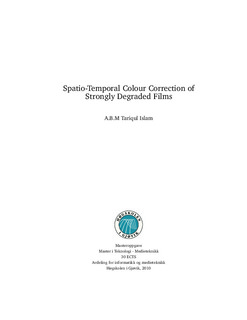| dc.description.abstract | The archives of motion pictures represent an important part of precious cultural heritage. But unfortunately, these collections of cinematography are vulnerable to different types of distortions; specially, the effect caused by chemical support on which they are recorded becomes unstable with time, unless they are stored at low temperature. Some defects on colour movies, such as colour fading, are irreversible and hence it is beyond the capability of photochemical restoration process. Though the spatial colour algorithms, like ACE and Retinex, provide helpful solution for restoration of degraded films, there are some challenges associated with these algorithms. Firstly, they work well if the colour degradation takes place mainly along the axes of the colour space. If, instead, the degradation has resulted in an increased correlation between the colour channels, they do not perform so well. Secondly, spatial colour algorithms tend to emphasize all details in the images, including defects such as dust and scratches. This may also influence the way the algorithm restores the colours in the regions surrounding the defect. And, finally, the algorithms are inherently computationally expensive. We propose here an automatic colour correction method which eventually automates the colour fading restoration process. The proposed method uses the STRESS model - an automatic image enhancement technique that deals with correcting colour images according to the Human Visual System.We also propose an efficient preprocessing technique which will be applied to the degraded images in prior to apply STRESS algorithm. The preprocessing technique, which includes Principle Component Analysis (PCA) and some sort of saturation enhancement, will ultimately make the resulting image more appealing and acceptable to Human Visual System.
We also presented a comparison scenario in case of processing time for frames between our method with STRESS and the ACE alogorithm. It is worth to mention that our method outperforms the method with ACE in case of processing time of the frames. Besides this, we depicted the comparison in case of maintainig the shape of histogram while covering the whole dynamic range between our suggested method and ACE. Since the spatial colour algorithms do not preserve some basic properties like the mean saturation and lightness value of the preprocessed image, we offered a very effective postprocessing method for preserving them. This method helps to produce pleasant final image by maintaining the expected saturation and lightness value. Apart from colour degradation, scratch line is another source of degradation in case of old movies. We have put an effort to analyze this problem and tested existing algorithm on our test movies to remove scratch line from the frames of the movies. Since, our main focus is on correcting the colour of the frames, we discussed this scratch line problem as an option and showed the effect of applying this scratch line removal algorithm on colour correction performance. We went beyond the spatial domain of the frames and extended our algorithm and implemented it on the temporal domain as well. We were able to achieve 80 percent reduction of the computational time for processing each frame in the temporal domain comparing to the processing time in the spatial domain for single frame. The implementation and achieved performance of our algorithm in case of both the spatial and temporal domain of the frames of old motion pictures were a great success in case of achieveing reduction of processing time comparing with existing algorithm, ACE and the colour correction result is also at a good acceptable stage from the Human Visual System. | en_US |
